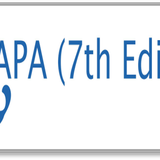The Financial Position Of Youth Employee: Pinning-Up Of Financial Capability And Income
DOI:
https://doi.org/10.24912/ja.v25i1.721Abstract
The aim of the study on the financial behavior of youth employees is to review the impact of financial capability, income on financial behavior in evaluating the financial position. The main target of this study is mediating the evaluation of financial behavior in the effort of increasing the financial position of youth employees. A research method conducts with a survey of 100 youth employees in Indonesia, particularly in Central Jakarta, that has more youth employees. Data from youth employees obtain through questionnaires and data is processed by SmartPLS; remember that analysis technique is using the path analysis model. Research results found that financial capability and income have a truly significant impact on financial behavior; likewise, it is directly to financial position. However, it known that financial behavior cannot directly influence to financial position. Research novelty explains that financial behavior cannot be mediation between financial capability and income to financial position. This finding is useful for youth employees in understanding the financial position and for the government in comprehending the financial behavior of youth employees. So, it expects to be able to give the policy of financial management for youth employees.
References
Alamsyah, D. P., Othman, N. A., and Mohammed, H. A. A. (2020). The awareness of environmentally friendly products: The impact of green advertising and green brand image. Management Science Letters, 10, 1961–1968. https://doi.org/10.5267/j.msl.2020.2.017.
Arianti, B. F. (2017). The Influence of Financial Literacy, Financial Behavior and Income on Investment Decision. European Research Studies Journal, 20(3A), 635–648.
Armijo, L. E., Mühlich, L., and Tirone, D. C. (2014). The systemic financial importance of emerging powers. Journal of Policy Modeling, 36(S1), S67–S88. https://doi.org/10.1016/j.jpolmod.2013.10.009.
Bohl, M. T., Klein, A. C., and Siklos, P. L. (2014). Short-selling bans and institutional investors’ herding behaviour: EVIDENCE from the global financial crisis. International Review of Financial Analysis, 33, 262–269. https://doi.org/10.1016/j.irfa.2014.03.004.
Bretscher, L., Julliard, C., and Rosa, C. (2016). Human capital and international portfolio diversification: A reappraisal. Journal of International Economics, 99, S78–S96. https://doi.org/10.1016/j.jinteco.2015.12.007.
Chen, M. H., and Lin, C. P. (2015). Understanding corporate philanthropy in the hospitality industry. International Journal of Hospitality Management, 48, 150–160. https://doi.org/10.1016/j.ijhm.2015.04.001.
Danilov, A., Biemann, T., Kring, T., and Sliwka, D. (2013). The dark side of team incentives: Experimental evidence on advice quality from financial service professionals. Journal of Economic Behavior and Organization, 93, 266–272. https://doi.org/10.1016/j.jebo.2013.03.012.
Delis, M. D., and Mylonidis, N. (2015). Trust, happiness, and households’ financial decisions. Journal of Financial Stability, 20, 82–92. https://doi.org/10.1016/j.jfs.2015.08.002.
Díaz Caro, C., and Crespo Cebada, E. (2016). Taxation of capital gains and Lock-in effect in the Spanish Dual Income Tax. European Journal of Management and Business Economics, 25(1), 15–21. https://doi.org/10.1016/j.redee.2015.11.001.
Dwiastanti, A. (2017). Analysis of financial knowledge and financial attitude on locus of control and financial management behavior. Management and Business Review, 1(1), 1–8.
El-Khatib, R., Fogel, K., and Jandik, T. (2015). CEO network centrality and merger performance. Journal of Financial Economics, 116(2), 349–382. https://doi.org/10.1016/j.jfineco.2015.01.001.
Fauceglia, D. (2014). Credit constraints and firm imports of capital goods: Evidence from middle- and low-income countries. International Economics, 140, 1–18. https://doi.org/10.1016/j.inteco.2014.07.002.
Gaganis, C., and Pasiouras, F. (2013). Financial supervision regimes and bank efficiency: International evidence. Journal of Banking and Finance, 37(12), 5463–5475. https://doi.org/10.1016/j.jbankfin.2013.04.026.
Gelman, M., Jochem, A., Reitz, S., and Taylor, M. P. (2015). Real financial market exchange rates and capital flows. Journal of International Money and Finance, 54, 50–69. https://doi.org/10.1016/j.jimonfin.2015.02.004.
Georgescu, D., and Mates, D. (2017). Influencing The Performance and Financial Position as Reported in The Annual Financial Statements Using Creative Methods. North Economic Review, I(1), 104–108.
Godlewski, C. J. (2014). Bank loans and borrower value during the global financial crisis: Empirical evidence from France. Journal of International Financial Markets, Institutions and Money, 28(1), 100–130. https://doi.org/10.1016/j.intfin.2013.10.009.
Goedde-Menke, M., Langer, T., and Pfingsten, A. (2014). Impact of the financial crisis on bank run risk - Danger of the days after. Journal of Banking and Finance, 40(1), 522–533. https://doi.org/10.1016/j.jbankfin.2013.11.028.
Haeussler, C., and Sauermann, H. (2013). Credit where credit is due? the impact of project contributions and social factors on authorship and inventorship. Research Policy, 42(3), 688–703. https://doi.org/10.1016/j.respol.2012.09.009.
Handgraaf, M. J. J., Van Lidth de Jeude, M. A., and Appelt, K. C. (2013). Public praise vs. private pay: Effects of rewards on energy conservation in the workplace. Ecological Economics, 86, 86–92. https://doi.org/10.1016/j.ecolecon.2012.11.008.
Hariyanto, O. I. B., and Alamsyah, D. P. (2019). The Relationship Of Environmental Knowledge And Green Purchase Intention. International Journal of Engineering and Advanced Technology, 8(5), 142–144. https://doi.org/10.35940/ijeat.E1020.0585C19.
Henager, R., and Cude, B. J. (2016). Financial Literacy and Long- and Short-Term Financial Behavior in Different Age Groups. Journal of Financial Counseling and Planning, 27(1), 3–19.
Holmes, M. J., and Maghrebi, N. (2016). Financial market impact on the real economy: An assessment of asymmetries and volatility linkages between the stock market and unemployment rate. Journal of Economic Asymmetries, 13, 1–7. https://doi.org/10.1016/j.jeca.2015.10.003.
Indris, S., and Primiana, I. (2015). Internal And External Environment Analysis On The Performance Of Small And Medium Industries Smes In Indonesia. International Journal of Scientific & Technology Research, 4(4), 188–196.
Kadoya, Y., and Khan, M. (2017). Explaining Financial Literacy in Japan: New Evidence Using Financial Knowledge, Behavior, and Attitude. SSRN Electronic Journal, February. https://doi.org/10.2139/ssrn.3067799.
Kenç, T., Erdem, F. P., and Ünalmış, İ. (2016). Resilience of emerging market economies to global financial conditions. Central Bank Review, 16(1), 1–6. https://doi.org/10.1016/j.cbrev.2016.03.002.
Killip, G. (2013). Products, practices and processes: Exploring the innovation potential for low-carbon housing refurbishment among small and medium-sized enterprises (SMEs) in the UK construction industry. Energy Policy, 62, 522–530. https://doi.org/10.1016/j.enpol.2013.06.024.
Košak, M., Li, S., Lončarski, I., and Marinč, M. (2015). Quality of bank capital and bank lending behavior during the global financial crisis. International Review of Financial Analysis, 37, 168–183. https://doi.org/10.1016/j.irfa.2014.11.008.
Laforet, S. (2007). British grocers’ brand extension in financial services. Journal of Product and Brand Management, 16(2), 82–97. https://doi.org/10.1108/10610420710739964.
Lee, C. C., Lin, C. W., and Zeng, J. H. (2016). Financial liberalization, insurance market, and the likelihood of financial crises. Journal of International Money and Finance, 62, 25–51. https://doi.org/10.1016/j.jimonfin.2015.12.002.
Levis, M., Meoli, M., and Migliorati, K. (2014). The rise of UK Seasoned Equity Offerings (SEOs) fees during the financial crisis: The role of institutional shareholders and underwriters. Journal of Banking and Finance, 48, 13–28. https://doi.org/10.1016/j.jbankfin.2014.04.034.
Mirvis, P. H., Hurley, S. T., and MacArthur, A. (2014). Transforming executives into corporate diplomats: The power of global pro bono service. Organizational Dynamics, 43(3), 235–245. https://doi.org/10.1016/j.orgdyn.2014.08.010.
Moradi, Z. S., Mirzaeenejad, M., and Geraeenejad, G. (2016). Effect of Bank-Based or Market-Based Financial Systems on Income Distribution in Selected Countries. Procedia Economics and Finance, 36(16), 510–521. https://doi.org/10.1016/s2212-5671(16)30067-3.
Moreland, K. A. (2018). Seeking financial advice and other desirable financial behaviors. Journal of Financial Counseling and Planning, 29(2), 198–207. https://doi.org/10.1891/1052-3073.29.2.198.
Newberry, S. (2015). Public sector reforms and sovereign debt management: Capital market development as strategy? Critical Perspectives on Accounting, 27, 101–117. https://doi.org/10.1016/j.cpa.2013.10.006.
Norden, L., Silva Buston, C., and Wagner, W. (2014). Financial innovation and bank behavior: Evidence from credit markets. Journal of Economic Dynamics and Control, 43, 130–145. https://doi.org/10.1016/j.jedc.2014.01.015.
Pedersen, E. R. G., and Sudzina, F. (2012). Which firms use measures?: Internal and external factors shaping the adoption of performance measurement systems in Danish firms. International Journal of Operations and Production Management, 32(1), 4–27. https://doi.org/10.1108/01443571211195718.
Pi, S.-M., Liao, H.-L., and Chen, H.-M. (2012). Factors That Affect Consumers’ Trust and Continuous Adoption of Online Financial Services. International Journal of Business and Management, 7(9), 108–119. https://doi.org/10.5539/ijbm.v7n9p108.
Pintea, M.-O., Stanca, L., Achim, S.-A., and Pop, I. (2014). Is there a Connection among Environmental and Financial Performance of a Company in Developing Countries? Evidence from Romania. Procedia Economics and Finance, 15(14), 822–829. https://doi.org/10.1016/s2212-5671(14)00527-9.
Rai, K., Dua, S., and Yadav, M. (2019). Association of Financial Attitude, Financial Behaviour and Financial Knowledge Towards Financial Literacy: A Structural Equation Modeling Approach. FIIB Business Review, 8(1), 51–60. https://doi.org/10.1177/2319714519826651.
Ramanathan, R., Ramanathan, U., and Zhang, Y. (2016). Linking operations, marketing and environmental capabilities and diversification to hotel performance: A data envelopment analysis approach. International Journal of Production Economics, 176, 111–122. https://doi.org/10.1016/j.ijpe.2016.03.010.
Rehman, K. U., Akhtar, H., and Shah, S. Z. A. (2019). Framing Effect and Financial Wellbeing: Role of Investment Behaviors as Mediator. Review of Economics and Development Studies, 5(2), 343–354. https://doi.org/10.26710/reads.v5i2.555.
Sawarjuwono, T. (2003). Intellectual Capital: Perlakuan, Pengukuran Dan Pelaporan (Sebuah Library Research). Jurnal Akuntansi Dan Keuangan, 5(1), 35–57. https://doi.org/10.9744/jak.5.1.pp.35-57.
Sawitri, N. N., and Astuty, P. (2018). Market anomalies and effect on returns. European Research Studies Journal, 21(2), 630–649. https://doi.org/10.35808/ersj/1029.
Sawitri, Ni Nyoman. (2019). FDPM after the global price crisis in the coal industry. International Journal of Monetary Economics and Finance, 12(1), 59–74. https://doi.org/10.1504/IJMEF.2019.098699.
Sawitri, Ni Nyoman, Ermayanti, D., Farida, U., Junus, D., Baharuddin, Hasmin, Yusriadi, Rachman, E., Jumra, and Vikaliana, R. (2019). Human Resources Competency, the Use of Information Technology and Internal Accounting Control on Time Procurement of Financial Reporting. Journal of Physics: Conference Series, 1175(1). https://doi.org/10.1088/1742-6596/1175/1/012263.
Schwartz, H. (2010). Does Akerlof and Shiller’s Animal Spirits provide a helpful new approach for macroeconomics? Journal of Socio-Economics, 39(2), 150–154. https://doi.org/10.1016/j.socec.2010.02.018.
Shen, C. H., Wu, M. W., Chen, T. H., and Fang, H. (2016). To engage or not to engage in corporate social responsibility: Empirical evidence from global banking sector. Economic Modelling, 55, 207–225. https://doi.org/10.1016/j.econmod.2016.02.007.
Shivam Dube, V., and Kumar Asthana, P. (2017). A Comparative Study on Financial Literacy of Uttar Pradesh with Central Zone States in India. Journal of Business and Management, 19(10), 22–27. https://doi.org/10.9790/487X-1910032227.
Singal, M. (2014). The business case for diversity management in the hospitality industry. International Journal of Hospitality Management, 40, 10–19. https://doi.org/10.1016/j.ijhm.2014.02.009.
Sydler, R., Haefliger, S., and Pruksa, R. (2014). Measuring intellectual capital with financial figures: Can we predict firm profitability? European Management Journal, 32(2), 244–259. https://doi.org/10.1016/j.emj.2013.01.008.
Szendrey, J., and Fiala, L. (2018). “I think I can get ahead!” perceived economic mobility, income, and financial behaviors of young adults. Journal of Financial Counseling and Planning, 29(2), 290–303. https://doi.org/10.1891/1052-3073.29.2.290.
Totenhagen, C. J., Wilmarth, M. J., Serido, J., Curran, M. A., and Shim, S. (2019). Pathways from Financial Knowledge to Relationship Satisfaction: The Roles of Financial Behaviors, Perceived Shared Financial Values with the Romantic Partner, and Debt. Journal of Family and Economic Issues, 40(3), 423–437. https://doi.org/10.1007/s10834-019-09611-9.
Vithessonthi, C., and Kumarasinghe, S. (2016). Financial development, international trade integration, and stock market integration: Evidence from Asia. Journal of Multinational Financial Management, 35, 79–92. https://doi.org/10.1016/j.mulfin.2016.03.001.
Wang, Y. K. M., Chung, C. C., and Lim, D. S. K. (2015). The drivers of international corporate entrepreneurship: CEO incentive and CEO monitoring mechanisms. Journal of World Business, 50(4), 742–753. https://doi.org/10.1016/j.jwb.2015.02.002.
Wilmarth, M. J. (2017). Financial Behaviors of Military Households: The Role of Financial Literacy and Financial Education. Consumer Interests Annual, 63(1), 1–2.
Wong, R., Ng, P., Bonino, J., Gonzaga, A. M., and Mieczkowski, A. E. (2018). Financial Attitudes and Behaviors of Internal Medicine and Internal Medicine-Pediatrics Residents. Journal of Graduate Medical Education, 10(6), 639–645. https://doi.org/10.4300/JGME-D-18-00015.1.
Xiao, J. J., and Porto, N. (2016). Financial Education and Financial Satisfaction: Financial Literacy, Behavior, and Capability as Mediators. International Journal of Bank Marketing. https://doi.org/10.1108/IJBM-01-2016-0009.
Yusoff, W. F. W., and Adamu, M. S. (2016). The relationship between corporate social responsibility and financial performance: Evidence from Malaysia. In International Business Management (Vol. 10, Issue 4, pp. 345–351). https://doi.org/10.3923/ibm.2016.345.351.
Downloads
Published
How to Cite
Issue
Section
License

This work is licensed under a Creative Commons Attribution-NonCommercial-ShareAlike 4.0 International License.
This journal provides immediate open access to its content on the principle that making research freely available to the public supports a greater global exchange of knowledge.

This work is licensed under a Creative Commons Attribution-NonCommercial-ShareAlike 4.0 International License



















